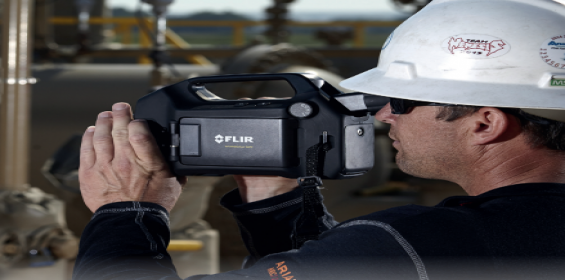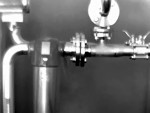Understanding cooled vs uncooled optical gas imaging
Published: 17 November, 2022
Craig O’Neill and Ron Lucier look at how to choose a cooled or uncooled OGI camera.
For more than a decade, FLIR Systems has manufactured infrared (IR) cameras to visualise gas leaks of various kinds. These optical gas imaging (OGI) cameras are developed to “see” a variety of gases including hydrocarbons, carbon dioxide, sulfur hexafluoride, refrigerants, carbon monoxide, ammonia and more. These imagers are used for many applications by various industries, including mitigating emissions, increasing production efficiency, and ensuring safe work environments. One great advantage of OGI cameras compared with other inspection technologies is the speed in which the technology can locate leaking components without interrupting the industrial process.
When choosing what camera you need for your OGI needs, the first factor to consider is ensuring the camera in question can visualise your gas. After you have done that, the decision may not always be simple and should not be based solely on price.
While they may be higher in price, there are considerable advantages of a cooled OGI camera. These units fall into the functional region of hydrocarbon gases, meaning only one camera would be required to visualise a wide variety of gases. In some cases, multiple cameras would be needed in the fingerprint region to achieve the same results. Another unique advantage of a midwave camera is the lack of interference from water vapours. Water vapour has strong absorption in the longwave or fingerprint region which could cause image uncertainty when using a camera.
Increased sensitivity and image quality are important factors to consider when choosing an OGI camera. These not only impact the ability to visualise small leaks but may also be considerable factors when trying to meet regulatory standards. There are also feature considerations when choosing a camera where a cooled OGI camera is beneficial.
The only Hazardous Location-certified handheld OGI cameras in the market are cooled detector cameras. If you require or desire the ability to quantify your gas leak, this is solely done with an OGI camera in the midwave spectrum, such as the GF320, and proprietary software found in the FLIR QL320 quantitative solution.
The FLIR GF620 cooled optical gas imaging camera and the FLIR GF77 uncooled Gas Finder camera. With the introduction of uncooled OGI cameras in the market, there are advantages of this new technology. First and foremost, the cost to manufacture an uncooled camera is considerably lower which results in a lower market price. They also cost less to maintain due to the simplicity in design with no cooler needed—potentially making them more appropriate for continuous, 24/7 operation applications.
Cooled vs uncooled detectors
Cooled OGI cameras use quantum detectors that require cooling to cryogenic temperatures (around 77 K or -321°F) and can be either midwave or longwave detectors. Midwave cameras that detect hydrocarbon gases in the functional region, such as methane, commonly operate in the 3-5 m range and use an indium antimonide (InSb) detector. Cooled longwave cameras that detect gases such as SF6 operate in the 8-12 m range and may use a quantum well infrared photodetector (QWIP). A cooled OGI camera has an imaging sensor that is integrated with a cryocooler that lowers the sensor temperature to cryogenic temperatures. This reduction in sensor temperature is necessary to reduce the noise to a level below that of the signal from the scene being imaged. Cryocoolers have moving parts made to extremely close mechanical tolerances that wear out over time, as well as helium gas that slowly works its way past gas seals. Eventually a rebuild for the cryocooler is required after 10,000-13,000 hours of operation.
Cameras with cooled detectors have a filter that is attached to the detector. This design prevents any stray radiation exchange between the filter and the detector which allows for better image sensitivity. This increase in image sensitivity could cause the imager to visualise certain gases more effectively and even allow the OGI camera to meet regulatory standards like the US EPA’s OOOOa or other requirements.
Uncooled OGI cameras use a microbolometer detector that does not require the additional parts necessary to cool a detector. These are often made of vanadium oxide (VOx) or amorphous silicone (a-Si) and are responsive in the 7-14 m range. They are much easier to manufacture than cooled cameras but lack the sensitivity, or Noise Equivalent Temperature Difference (NETD), which makes it more difficult to visualise smaller gas leaks. NETD is a figure of merit which represents the minimum temperate difference a camera can resolve. A better NETD would result in a cooled OGI camera detecting gas at least five times better than uncooled. A similar standard used to determine how well an OGI camera can detect gas is Noise Equivalent Concentration Length (NECL) which determines how much gas can be detected over a defined pathlength. As an example, the NECL of a FLIR GF320 cooled OGI camera (3-5 m detector) for methane detection is less than 20 ppm*m whereas the NECL of an uncooled solution (7-14 m detector) is more than 100 ppm*m.
Another consideration with uncooled OGI cameras is the filter. Some cameras are not filtered in the longwave spectra meaning they are just a wide-open detector using unique analytics to visualise a gas.
FLIR’s patented High Sensitivity Mode (HSM) is an example of a camera utilising software and analytics to enhance the visualisation of gas. Some cameras have more targeted filters built into the camera system. These could be associated with the lens, between the camera and lens, or engineered in several ways.
With uncooled filtering, you lose thermal sensitivity due to limiting the radiation that reaches the camera’s detector. This would result in a higher NETD but could present a better image related to gas imaging. As the spectral filter width is narrowed to focus on specific gases, the radiation from the scene decreases while the noise of the detector remains the same and the reflected radiation from the filter increases. This results in creating a much higher quality image related to gas imaging but decreases the camera’s thermal sensitivity for temperature measurement (radiometry). When you have a cold filter, as in a cooled OGI camera, this phenomenon is avoided since there are very small amounts of radiation from reflections.
Whether you are looking to save money, meet regulatory standards, increase worker safety, or simply to be a good environmental steward, the options are greater than ever and can sometimes be confusing. Many factors can go into a decision to choose an OGI camera beyond price.
https://www.linkedin.com/company/flir-systems/






 FLIR Systems GF343 is said to be a high performance gas imaging camera designed to visually detect Carbon Dioxide (CO2) in real time. The company says incorporating a cooled Indium Antimonide (InSb) detector the FLIR GF343 is able to provide sensitive detection of even tiny CO2 gas leaks. Carbon Dioxide gas leaks are displayed as plumes of vapour in the camera's infrared image.
FLIR Systems GF343 is said to be a high performance gas imaging camera designed to visually detect Carbon Dioxide (CO2) in real time. The company says incorporating a cooled Indium Antimonide (InSb) detector the FLIR GF343 is able to provide sensitive detection of even tiny CO2 gas leaks. Carbon Dioxide gas leaks are displayed as plumes of vapour in the camera's infrared image.
